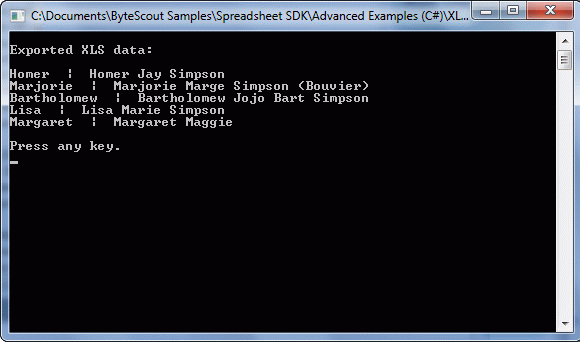How to convert XLS to SQL Server data using Bytescout Spreadsheet SDK for .NET
These samples shows how to export XLS to SQL Server data in VB and C# using Bytescout Spreadsheet SDK.
You can also check out How to convert XLS to SQL Server data via CSV BULK INSERT tutorial.
Input XLS file:

Output – XLS data exported to SQL Server:

Visual Basic .NET
Imports System.IO
Imports Bytescout.Spreadsheet
Imports System.Data.SqlClient
Class Program
Friend Shared Sub Main(args As String())
Try
' MODIFY THE CONNECTION STRING WITH YOUR CREDENTIALS!!!
Dim connectionString As String = "Data Source=localhost;Initial Catalog=master;Integrated Security=true;"
Using connection As New SqlConnection(connectionString)
connection.Open()
' Drop test database if exists
ExecuteQueryWithoutResult(connection, "IF DB_ID ('XlsTests') IS NOT NULL DROP DATABASE XlsTests")
' Create empty database
ExecuteQueryWithoutResult(connection, "CREATE DATABASE XlsTests")
' Switch to created database
ExecuteQueryWithoutResult(connection, "USE XlsTests")
' Create a table for XLS data
ExecuteQueryWithoutResult(connection, "CREATE TABLE XlsTest (Name VARCHAR(40), FullName VARCHAR(255))")
' Load XLS document
Using document As New Spreadsheet("SimpleReport.xls")
Dim worksheet As Worksheet = document.Workbook.Worksheets(0)
For row As Integer = 0 To worksheet.UsedRangeRowMax
Dim insertCommand As [String] = String.Format("INSERT XlsTest VALUES('{0}','{1}')", worksheet.Cell(row, 0).Value, worksheet.Cell(row, 1).Value)
ExecuteQueryWithoutResult(connection, insertCommand)
Next
End Using
' Check the data successfully exported
Using command As New SqlCommand("SELECT * from XlsTest", connection)
Dim reader As SqlDataReader = command.ExecuteReader()
If reader IsNot Nothing Then
Console.WriteLine()
Console.WriteLine("Exported XLS data:")
Console.WriteLine()
While reader.Read()
Console.WriteLine([String].Format("{0} | {1}", reader(0), reader(1)))
End While
End If
End Using
Console.WriteLine()
Console.WriteLine("Press any key.")
Console.ReadKey()
End Using
Catch ex As Exception
Console.WriteLine("Error: " & ex.Message)
Console.ReadKey()
End Try
End Sub
Private Shared Sub ExecuteQueryWithoutResult(connection As SqlConnection, query As String)
Using command As New SqlCommand(query, connection)
command.ExecuteNonQuery()
End Using
End Sub
End Class
Visual C#
using System;
using System.IO;
using Bytescout.Spreadsheet;
using System.Data.SqlClient;
namespace ExportToSQLServer
{
class Program
{
static void Main(string[] args)
{
try
{
// MODIFY THE CONNECTION STRING WITH YOUR CREDENTIALS!!!
string connectionString = “Data Source=localhost;Initial Catalog=master;Integrated Security=true;”;
using (SqlConnection connection = new SqlConnection(connectionString))
{
connection.Open();
// Drop test database if exists
ExecuteQueryWithoutResult(connection,
“IF DB_ID (‘XlsTests’) IS NOT NULL DROP DATABASE XlsTests”);
// Create empty database
ExecuteQueryWithoutResult(connection, “CREATE DATABASE XlsTests”);
// Switch to created database
ExecuteQueryWithoutResult(connection, “USE XlsTests”);
// Create a table for XLS data
ExecuteQueryWithoutResult(connection,
“CREATE TABLE XlsTest (Name VARCHAR(40), FullName VARCHAR(255))”);
// Load XLS document
using (Spreadsheet document = new Spreadsheet(“SimpleReport.xls”))
{
Worksheet worksheet = document.Workbook.Worksheets[0];
for (int row = 0; row <= worksheet.UsedRangeRowMax; row++) { String insertCommand = string.Format("INSERT XlsTest VALUES('{0}','{1}')", worksheet.Cell(row, 0).Value, worksheet.Cell(row, 1).Value); ExecuteQueryWithoutResult(connection, insertCommand); } } // Check the data successfully exported using (SqlCommand command = new SqlCommand("SELECT * from XlsTest", connection)) { SqlDataReader reader = command.ExecuteReader(); if (reader != null) { Console.WriteLine(); Console.WriteLine("Exported XLS data:"); Console.WriteLine(); while (reader.Read()) { Console.WriteLine(String.Format("{0} | {1}", reader[0], reader[1])); } } } Console.WriteLine(); Console.WriteLine("Press any key."); Console.ReadKey(); } } catch(Exception ex) { Console.WriteLine("Error: " + ex.Message); Console.ReadKey(); } } static void ExecuteQueryWithoutResult(SqlConnection connection, string query) { using (SqlCommand command = new SqlCommand(query, connection)) { command.ExecuteNonQuery(); } } } } [/vb]